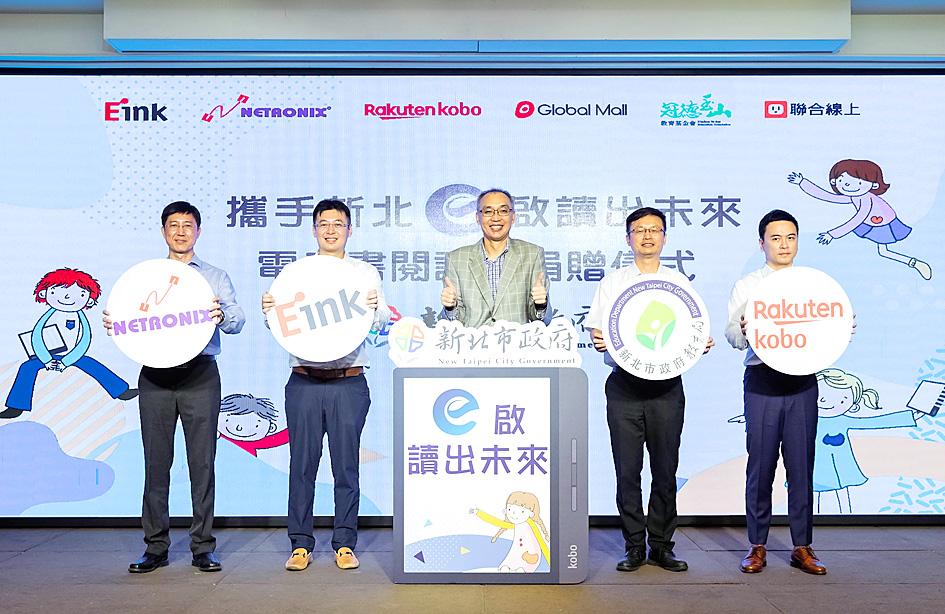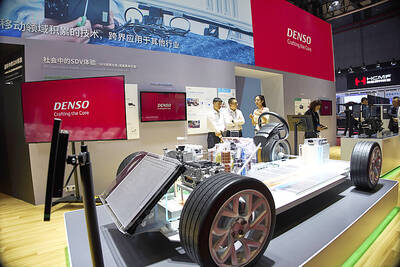E Ink Holdings Inc (元太科技), the world’s sole supplier of e-paper displays, expects revenue to climb to a four-year high this year as the COVID-19 pandemic helps fuel demand for e-readers and electronic shelf labels during the year-end shopping season.
The Hsinchu-based company said that retailers are accelerating adoption of electronic shelf labels to avoid virus transmission routes as well as to enhance delivery efficiency, as COVID-19 infections remain severe in the US and Europe.
Consumers are buying e-readers, tablet computers and laptops for remote learning or entertainment, instead of other items, as they are confined at home amid the pandemic, E Ink said.

Photo courtesy of E Ink Holdings Inc
The company is to introduce its new colored e-paper displays used in e-readers in the final quarter of this year.
Demand for its new color e-paper displays, dubbed Kaleido, has also improved and the firm is boosting capacity 10-fold, it said.
“This year will be the best year in terms of revenue after the company transformed itself into a pure e-paper display supplier in 2016,” E Ink chairman Johnson Lee (李政昊) told reporters on the sidelines of a news conference in New Taipei City’s Banciao District (板橋).
“Our order visibility is improving. We are seeing quite good momentum carrying into the first quarter of next year,” Lee said. “There will be year-on-year growth in revenue during the first quarter.”
“Customers are adding new orders constantly,” he said.
To meet customers’ rapidly growing demand for electronic shelf displays, E Ink is also expanding capacities in the US and in Hsinchu.
E Ink’s revenue grew 9.2 percent year-on-year to NT$11.1 billion (US$383.82 million) during the first nine months of this year, from NT$10.17 billion, after revenue last month rose to the highest level in 11 months at NT$1.53 billion.
E-readers and electronic shelf labels are the two major applications that drive demand for its e-paper displays, E Ink said.
E-paper displays for e-readers account for 60 percent of the firm’s revenue, it said.

GROWING OWINGS: While Luxembourg and China swapped the top three spots, the US continued to be the largest exposure for Taiwan for the 41st consecutive quarter The US remained the largest debtor nation to Taiwan’s banking sector for the 41st consecutive quarter at the end of September, after local banks’ exposure to the US market rose more than 2 percent from three months earlier, the central bank said. Exposure to the US increased to US$198.896 billion, up US$4.026 billion, or 2.07 percent, from US$194.87 billion in the previous quarter, data released by the central bank showed on Friday. Of the increase, about US$1.4 billion came from banks’ investments in securitized products and interbank loans in the US, while another US$2.6 billion stemmed from trust assets, including mutual funds,

AI TALENT: No financial details were released about the deal, in which top Groq executives, including its CEO, would join Nvidia to help advance the technology Nvidia Corp has agreed to a licensing deal with artificial intelligence (AI) start-up Groq, furthering its investments in companies connected to the AI boom and gaining the right to add a new type of technology to its products. The world’s largest publicly traded company has paid for the right to use Groq’s technology and is to integrate its chip design into future products. Some of the start-up’s executives are leaving to join Nvidia to help with that effort, the companies said. Groq would continue as an independent company with a new chief executive, it said on Wednesday in a post on its Web

JOINT EFFORTS: MediaTek would partner with Denso to develop custom chips to support the car-part specialist company’s driver-assist systems in an expanding market MediaTek Inc (聯發科), the world’s largest mobile phone chip designer, yesterday said it is working closely with Japan’s Denso Corp to build a custom automotive system-on-chip (SoC) solution tailored for advanced driver-assistance systems and cockpit systems, adding another customer to its new application-specific IC (ASIC) business. This effort merges Denso’s automotive-grade safety expertise and deep vehicle integration with MediaTek’s technologies cultivated through the development of Media- Tek’s Dimensity AX, leveraging efficient, high-performance SoCs and artificial intelligence (AI) capabilities to offer a scalable, production-ready platform for next-generation driver assistance, the company said in a statement yesterday. “Through this collaboration, we are bringing two

Even as the US is embarked on a bitter rivalry with China over the deployment of artificial intelligence (AI), Chinese technology is quietly making inroads into the US market. Despite considerable geopolitical tensions, Chinese open-source AI models are winning over a growing number of programmers and companies in the US. These are different from the closed generative AI models that have become household names — ChatGPT-maker OpenAI or Google’s Gemini — whose inner workings are fiercely protected. In contrast, “open” models offered by many Chinese rivals, from Alibaba (阿里巴巴) to DeepSeek (深度求索), allow programmers to customize parts of the software to suit their